Exploring the Latest Developments in Dubai Metro Connectivity
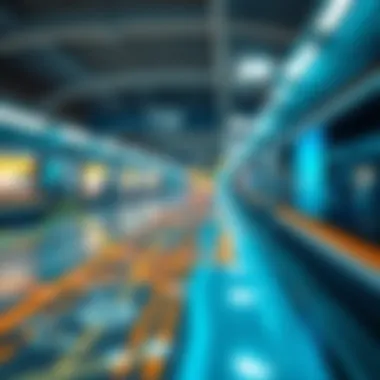
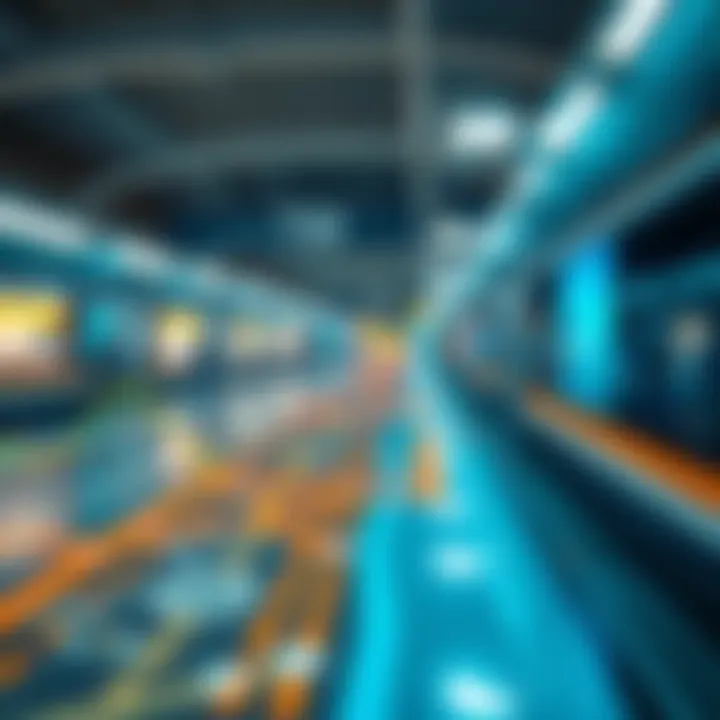
Intro
Dubai, a city that captures the imagination with its towering skyscrapers and vibrant lifestyle, is continuously redefining urban connectivity through its metro system. The latest map showcases not just a network of trains, but a framework shaping the city's growth, offering access to vital economic hubs, residential areas, and cultural landmarks. In this guide, we will explore the intricacies of the Dubai Metro map, how it serves as a linchpin for real estate and urban development, and what potential investors and residents should consider in this evolving landscape.
Market Insights
Latest Trends in Dubai Real Estate
The real estate market in Dubai has been on a rollercoaster ride lately. Some areas are booming thanks to the metro’s expansion, leading to increased property demand. For example, neighborhoods like Dubai Marina and Business Bay, now well-connected via the metro, are witnessing a surge in both rental prices and sales. Investors are particularly keen on these regions because of the anticipated returns on properties that are in close proximity to metro stations.
- Demand Surge: With more expats looking for homes near these key transit points, competition has intensified, driving prices upward.
- Rental Opportunities: Investors are also trying to tap into the rental market, as properties near the metro become more appealing to tenants seeking convenience.
Impact of Global Events on Local Market
Global phenomena like the Expo 2020 have had significant ripple effects on Dubai’s market. Events of this scale not only attract tourists but also pique the interest of investors. The metro played a pivotal role in this, connecting key venues with residential and commercial hubs.
As people flock to the city, the demand for real estate continues to grow, certainly making areas close to metro lines more valuable. However, fluctuations in international markets can pose challenges as well— economic downturns abroad may cool local purchases.
"Public transport's efficacy can significantly sway real estate value. Areas connected to fast transport often sustain higher property values, particularly in a city as dynamic as Dubai."
Investment Opportunities
High-Return Areas for Property Investment
When it comes to property investment in Dubai, choosing the right location can make or break your investment success. Here are a few areas to consider:
- Dubai Hills Estate: With its vast community space and proximity to metro expansion, it presents attractive options for families and investors alike.
- Jumeirah Lake Towers (JLT): Not only is it a business hub, but also now well connected with easy access to the metro, making it a high-return investment zone.
- Deira: The older parts of the city are undergoing rejuvenation. Development works are underway, with metro connectivity slated to enhance its appeal significantly.
Tips for First-Time Investors
Diving into Dubai’s real estate can feel daunting, especially for newcomers. Here are some recommendations:
- Research Areas Thoroughly: Knowing what neighborhoods are connected to the metro can provide a head start.
- Stay Updated: Engage with local property forums or websites such as reddit.com for insights and trends.
- Consult Experts: Working with local agents who understand the market dynamics can save time and lead to better investments.
Before making any investments, consider visiting the areas yourself to get a feel for the neighborhoods. Experiencing Dubai’s unique blend of culture, lifestyle, and infrastructure can highlight the hidden gems that aren't always evident on a map.
Closure
As we have explored, the latest Dubai Metro map is much more than a transit blueprint. It is a vital driver of urban development and a catalyst for real estate opportunities within the city. With advances in connectivity, investors and residents alike must navigate this landscape thoughtfully, taking into account market trends, real estate potential, and the overarching impact of global events. Understanding the dynamics of the metro system is key to making informed decisions in your property ventures in Dubai.
Prolusion to the Dubai Metro
The Dubai Metro stands as a critical component in the urban landscape of one of the world’s most dynamic cities. It's more than just a mode of transport; it symbolizes innovation, progress, and an ambitious vision for urban development. For investors, homebuyers, and expatriates, understanding the metro system's intricacies can open doors to lucrative opportunities while enhancing their daily commuting experiences.
The metro system, launched in 2009, rapidly evolved beyond mere public transport to an essential player in the strategic development of Dubai. By connecting diverse neighborhoods, it fuels economic activity, bringing convenience to bustling business districts and serene residential areas alike. With a clear focus on reducing traffic congestion and improving air quality, the metro also aligns well with the city’s sustainability goals.
History of the Metro System
The story of the Dubai Metro is nothing short of fascinating. The foundation was laid way back in the early 2000s, when the government first recognized the need to expand the city’s transport infrastructure. The planning stage aimed to tackle the pressing traffic jams and promote a more sustainable urban environment.
Once the blueprint was approved, construction kicked off with impressive speed, showcasing Dubai's commitment to efficiency and modernization. Notably, the Red Line became operational in 2010, setting a benchmark for rapid transit systems in the region. The Blue Line followed suit, enhancing connectivity across key areas. Over the years, the system's expansion continued, integrating advanced technology and infrastructure enhancements, like driverless trains and automated ticketing systems.
Significance in Urban Infrastructure
The significance of the Dubai Metro transcends transportation; it catalyzes urban transformation. By providing a reliable and efficient way to navigate the city, the metro has reshaped real estate development patterns, often leading to increased property values near key transit stations.
Residents enjoy the luxury of effortless commutes, while businesses capitalize on the influx of clients who can easily access their establishments. This mutual benefit between urban planners and commercial entities fosters a thriving ecosystem that propels Dubai's economic engine.
"When public transport flourishes, the entire city thrives – it's not just about getting from point A to B; it’s about enhancing quality of life and driving economic growth."
In summary, understanding the history and significance of the Dubai Metro is vital for anyone navigating the real estate market or seeking to comprehend the city’s infrastructural advancements. With plans for future expansions underway, the metro’s influence on Dubai's urban landscape is set to grow even larger.
Overview of the Latest Dubai Metro Map
Understanding the latest Dubai Metro map is pivotal for grasping the growth and evolving landscape of this bustling metropolis. The metro network isn’t just an intricate web of routes; it symbolizes the very essence of urban mobility and planning in Dubai. With its rapid expansion, the metro has become the spine of the city’s public transport system, connecting various neighborhoods and reducing reliance on personal vehicles. As Dubai continues to attract a melting pot of expatriates and investors, knowing how to navigate this system opens doors to both convenience and opportunity.
Current Route Highlights
The latest map showcases several key routes that crisscross the heart of Dubai, making commuting smooth for both residents and tourists. Noteworthy among these are:
- Red Line: Stretching from Rashidiya to UAE Exchange, this line serves as the backbone, connecting major business districts and attractions like Dubai Mall and Burj Khalifa.
- Green Line: This line spans from Etisalat to Creek, efficiently linking residential areas with economic districts and cultural landmarks.
- Route 2020: A significant extension that connects the existing Red Line to the Expo 2020 site, enhancing accessibility during a time of global attention.
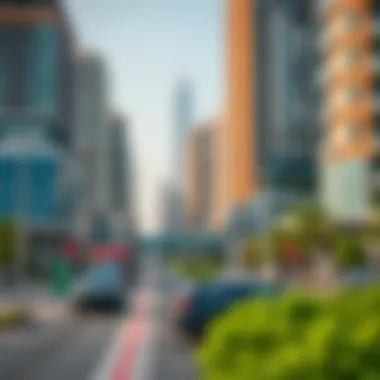

These routes not only ease traffic congestion but also significantly reduce travel time, allowing users to traverse the city efficiently. For example, a ride from the Dubai Marina to the airport, which might typically take over an hour by car, can be done in under 30 minutes via the metro.
Key Stations and Interchanges
When it comes to the Metro, certain stations stand out not just for their architectural beauty but also for their strategic importance.
- Burj Khalifa/Dubai Mall Station: This station is indispensable, granting access to one of the world’s leading retail and entertainment destinations. Direct connectivity here boosts foot traffic, benefiting local businesses.
- Union Station: An essential interchange station connecting both the Red and Green Lines, it seamlessly blends transit with commerce, as it is surrounded by shopping centers and eateries. For commuters, this station serves as a pivotal hub allowing quick transitions between lines.
- Dubai Marina Station: Perfectly situated for both residents and tourists, it opens doors to luxurious beachfront properties and dining venues. Here, the metro meets the vibrancy of the marina life, marrying the transport system with leisure pursuits.
By intertwining with various transport modes such as buses and water taxis, these stations enhance the overall efficiency of the transit network.
In summary, the latest Dubai Metro map reflects a structured approach to urban mobility. Each route and station is designed to facilitate not only effective transport but also to catalyze economic opportunities and urban development. As the city prepares for further expansions, an understanding of this map is not just beneficial; it’s essential for anyone looking to engage with the ever-evolving landscape of Dubai.
Integration with Other Transportation Modes
The integration of the Dubai Metro with various transportation modes is not just about convenience—it's a lifeline for commuters, tourists, and all who navigate this bustling metropolis. Given Dubai’s rapid growth and diverse population, creating a seamless transit system becomes imperative. In this light, understanding how different transport modes coexist with the Metro can unveil the intricacies of urban mobility in this dynamic city.
Bus Connectivity
The bus system in Dubai serves as a crucial extension of the Metro network. With an extensive reach that bridges areas not serviced directly by the Metro, buses ensure that even the farthest corners are within close grasp. Here's what makes this interconnectedness so vital:
- Frequency and Coverage: Buses run frequently, often matching Metro peak hours, facilitating smooth transfers. The overarching coverage means that commuters can easily hop on a bus from their home neighborhood to a Metro station, cutting down on travel times.
- Multiple Route Options: With a plethora of routes available, riders have choices that suit their specific destinations. This flexibility enhances the attractiveness of public transport and enables efficient planning of daily commutes.
- Integration Points: Many bus stops are strategically placed near Metro stations. This coordination minimizes waiting time, making the transition from one mode to another feel almost effortless. Shifting from a bus to a train becomes a matter of mere steps rather than a logistical hurdle.
An overwhelming majority of Dubai's residents rely on this interconnected system, leveraging the bus network to access the Metro and expand their mobility within the city.
Tram Systems and Water Taxis
In addition to buses, trams and water taxis complement the Metro, creating a multifaceted transportation tapestry. Each has its own uniqueness, enhancing Dubai's accessibility.
Tram Systems
The tram network, particularly in areas like Dubai Marina, connects seamlessly to the Metro, providing challenges and opportunities alike:
- Last-Mile Connectivity: Trams offer essential solutions for the last mile, efficiently linking Metro stops with local districts. Commuters often take a tram to narrow their journey down to their exact destination.
- Modern Infrastructure: The aesthetics of the trams reflect Dubai's commitment to modernity. Designed to provide both convenience and a pleasant experience, they add an attractive layer to urban travel.
Water Taxis
Water taxis are a unique feature of urban transit in Dubai, adding a distinct flavor to commuting:
- Scenic Routes: Traveling via water not only serves as a practical transportation option but also as an opportunity to enjoy scenic views of the city’s landmarks along the coastline and canals.
- Tourist Appeal: Water taxis appeal greatly to tourists. They provide a leisurely way to explore areas like the Dubai Water Canal while also connecting them to major hubs, including Metro stops.
“An integrated transport system in Dubai not only eases daily commutes but also encourages a culture of public transit use, which could significantly test the limits of urban development.”
For further insights, you can check the following resources:
- Wikipedia: Dubai Metro
- Britannica: Transportation in Dubai
- Official Dubai Roads and Transport Authority
Future Expansion Plans
Dubai's Metro system has been a game-changer in how residents and visitors navigate the bustling city. As it stands, this public transport network is not just about connecting dots on a map; it plays a pivotal role in shaping the city’s future. The plans for expansion carry significant weight, as they aim to enhance convenience, accessibility, and the overall urban environment.
The relevance of these future expansion plans lies in their potential to address several pressing needs:
- Increasing Capacity: The current system, while effective, can become congested during peak hours. Proposed expansions are designed to increase capacity, allowing for a smoother commute.
- Enhancing Connectivity: New lines aim to connect underserved areas, making it easier for residents to reach employment hubs, educational institutions, and recreational spaces.
- Boosting Economic Growth: Expanding metro lines can lead to burgeoning business opportunities. Areas once deemed inaccessible can suddenly flourish with retail, dining, and entertainment options.
Proposed New Lines
Among the proposed new lines, one noteworthy project is the Blue Line, which plans to span from the Dubai Marina through to the Dubai International Airport. This addition promises not only to reduce travel time significantly but also to integrate various travel modes. Here’s a closer look at some other proposed expansions:
- Red Line Extension to Dubai World Central could improve access to the upcoming Expo site, connecting a major event hub with the city.
- Green Line South extension that could link major residential communities to key commercial zones.
- The Purple Line, which aims to serve the densely populated areas of Al Quoz and Jumeirah.
These extensions represent a forward-thinking approach to urban planning, ensuring that Dubai maintains its momentum as an international city.
Impact on Real Estate Development
Real estate in Dubai has a unique relationship with transport developments, heavily influenced by the integration of metro lines into the urban fabric. Investors and homebuyers usually keep a close eye on proposed metro expansions, as proximity to a metro station can significantly enhance property values.
Considerations of the impact include:
- Price Appreciation: Properties located near the new metro lines often witness a substantial rise in value. Developers are well aware; hence many are strategically planning projects close to these expansions.
- Desirable Neighborhoods: Areas adjacent to new stations tend to become hotbeds for residential and commercial projects. Investors are actively seeking opportunities in these emerging neighborhoods, eyeing the high-return potential.
- Increased Demand for Amenities: As more people flock to areas near metro stations, the demand for facilities like shops, schools, and healthcare rises, leading to a vibrant community atmosphere.
“Transport developments, like the metro expansions, act as catalysts, turning silent zones into bustling hubs.”
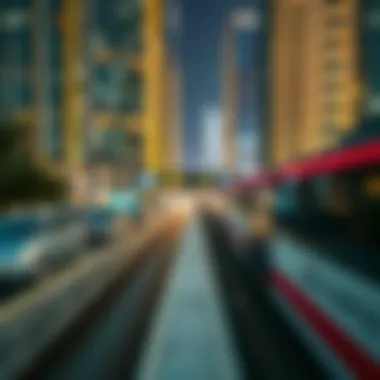

Market Trends Influenced by the Metro
The advent of the Dubai Metro has drastically reshaped the landscape of real estate and urban living in the city. Since its launch, it has become apparent that the metro system is not just a public transport initiative; it plays a pivotal role in defining property prices and encouraging the growth of new neighborhoods. Investors and homebuyers are increasingly considering proximity to the metro as a key factor in their decision-making process. The metro’s influence on market trends is multifaceted and worth exploring.
Property Prices Around Metro Stations
The close relationship between property prices and metro stations cannot be overstated. Studies show that properties situated near metro stations often command higher prices compared to those further away. Here are some critical points regarding this impact:
- Accessibility as a Value-Add: Properties near stations are perceived as more accessible, which is a significant selling point for both renters and buyers. For instance, in areas like Burj Khalifa and Downtown Dubai, prices for residential units tend to rise considerably due to their closeness to metro stations.
- Rental Yields: Investors typically see better rental yields in properties located close to transit options. Rentals are more favorable in neighborhoods with good transport links. Areas surrounding the Dubai Mall Metro Station have witnessed a surge in demand, leading to increased rental prices.
- Development Premium: As developers target the metro's expanding reach, there tends to be a development premium associated with new projects in these areas. Investors gain from both appreciation in property values and potential income generation from renting.
Overall, the correlation between property prices and metro station proximity illustrates how crucial public transport infrastructure is in establishing real estate value.
Emerging Neighborhoods
The metro's impact extends beyond just property prices; it's also a catalyst for the emergence of new neighborhoods. Here are some ways the metro is changing the urban fabric:
- New Developments: The metro’s planned extensions have sparked interest in previously underdeveloped areas such as Al Qouz and Dubai Hills, turning them into attractive destinations for potential homeowners. These formerly overlooked neighborhoods are now entering the spotlight, driven by increased connectivity.
- Commercial Growth: The presence of metro stations contributes to commercial growth, as businesses seek to capitalize on increased foot traffic. Cafes, restaurants, and retail centers are sprouting up near metro stops, thus enhancing the local economy and lifestyle.
- Community and Lifestyle: A sense of community is growing in emerging neighborhoods due to enhanced connectivity and social spaces connected with metro stations. This transforms the way people experience urban life, making these areas desirable and livable for families and professionals alike.
Accessibility and Convenience for Residents
The Dubai Metro plays a crucial role in enhancing the accessibility and convenience for residents across the city. With a modern, efficient transit system, the Metro not only connects key areas but also significantly impacts residents' daily lives by reducing travel times and enhancing mobility. The convenience of accessibility directly influences the overall quality of life, which is an essential consideration for both investors and homebuyers.
Among the notable benefits, the Metro system acts as a lifeline for many residents, ensuring easy navigation throughout the bustling city. Here are some key aspects that underline its importance:
- Efficient Connectivity: The Metro's network covers a vast area, linking various neighborhoods, business districts, and leisure spots. This efficient connectivity allows residents to reach their destinations effortlessly without relying heavily on personal vehicles.
- Time-Saving: For the average commuter, time is often of the essence. The Metro dramatically cuts down travel time compared to road transport, mainly during peak hours when traffic congestion is at its worst. A resident living in Dubai Marina can, for instance, zip over to the Burj Khalifa within about 20 minutes, a trip that could take significantly longer by car.
- Affordability: Compared to the rising costs associated with car ownership and fuel, utilizing the Metro proves to be a more budget-friendly option for daily travel. With reasonable fare structures and various pass options, it offers a reliable transport avenue for residents from diverse income brackets.
The Metro is not just transportation; it's a factor that shapes urban living, maximizing convenience while minimizing stress.
Time Efficiency for Commuters
With the pace of life in Dubai, time efficiency becomes paramount for commuters. The Dubai Metro tackles this head-on by providing a seamless travel experience.
- Frequent Service: Trains run at regular intervals, often every few minutes during peak hours. This minimizes waiting time and keeps the flow of commuters smooth. Therefore, even during rush hour, residents aren't left standing on crowded platforms for long.
- Direct Routes: Many popular destinations are served directly by the Metro, allowing residents to avoid the hassle of transfers. This direct accessibility translates to quicker trips. For example, routes from Jumeirah Lakes Towers to the Dubai Mall don't require any transfers, saving residents valuable minutes.
- Real-Time Updates: The Metro app offers real-time tracking and updates, meaning commuters can plan their journeys better, avoiding unnecessary delays. This leads to smoother travel experiences, allowing individuals to complete errands with optimal efficiency.
Eco-Friendly Transport Options
Sustainability is increasingly a priority in urban planning, and the Dubai Metro champions this cause by promoting eco-friendly transport options.
- Reduced Carbon Footprint: By encouraging the use of public transport, the Metro significantly reduces the number of vehicles on the road, which contributes to lower greenhouse gas emissions. Residents utilizing the Metro contribute to a more sustainable environment.
- Electric Trains: The Metro uses electric-powered trains, which further decreases reliance on fossil fuels. This aligns with Dubai's broader vision of creating a greener, more intelligent city.
- Integration with Other Eco-Friendly Options: The Metro system does not operate in isolation. It’s well-integrated with bus services, tram systems, and bike-sharing initiatives, creating a comprehensive urban transport framework that promotes a shift away from cars. Residents can easily transition from the Metro to a bus or tram, making it simpler to choose greener modes of transport for the entire journey.
In summary, the Dubai Metro is a fundamental element of the city’s infrastructure, offering residents not only convenience but also a reliable, time-efficient, and eco-conscious means of transportation.
Navigating the Metro System
The Dubai Metro is not just a mode of transportation; it’s the lifeline of the city, bridging the gap between various neighborhoods and essential hubs. It's crucial to understand how to effectively navigate this system, particularly for those who are new to Dubai or considering investing in property here. Efficient navigation can greatly enhance the commuter experience and save precious time, making it a vital topic for both residents and visitors alike.
Using the Metro App
In this digital age, convenience is key. The Dubai Metro App encapsulates that convenience by providing real-time updates and navigation assistance. Available on both Android and iOS, the app is user-friendly and packed with features. Users can easily track train schedules, check fares, and even receive alerts on any service disruptions.
The interface allows you to plan your trip seamlessly. One simply enters the starting point and destination, and voila! The app lays out the best route options. It also highlights how many stops until you reach your destination, so one won't be caught off guard. Furthermore, the app includes a map of the metro lines, making it a breeze for users to familiarize themselves with the stations and connections.
Key Features:
- Real-Time Updates: Get live information on train timings and delays.
- Trip Planner: Plan your journey in advance and save time.
- Station Information: Access details about facilities at each metro station.
This level of transparency fosters a sense of confidence in commuters, ensuring they feel well-equipped to navigate the metropolis.
Understanding Ticketing Options
Navigating the intricacies of the ticketing system can be a bit daunting, but it’s critical to ensure an optimal commuting experience. The Dubai Metro offers several ticketing options tailored to different needs and budgets, thus simplifying the process for users.
- NOL Card: The primary fare card, the NOL card, is a must-have for regular commuters. It comes in various categories: Red, Silver, Gold, and Blue, catering to tourists, daily riders, and even students.
- Single Journey Tickets: Ideal for infrequent travelers, these tickets simplify the process by allowing a one-off journey without the need for a NOL card.
The ticketing system is structured so that the fares are based on distance traveled, which makes the costs very affordable compared to other metropolitan areas. A crucial point to note is that ticket checks can happen at any time, so having a valid ticket is imperative.
Your choice of ticket can significantly impact your daily travel efficiency and budget. It's wise to evaluate your commuting habits before diving in.
The intuitive ticketing system reflects the city’s commitment to creating an efficient public transport atmosphere. Understanding these options can significantly enhance the experience for all metro users.
In summary, navigating the Dubai Metro system is an essential skill for anyone looking to explore the city or tap into its real estate market. Leveraging the features of the Metro App and understanding ticketing options can turn a potentially confusing experience into a seamless journey.
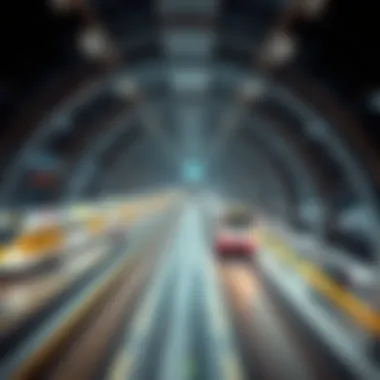

Challenges Faced by the Metro System
Despite the advancements and benefits the Dubai Metro system has brought to the urban landscape, it comes with its own set of challenges that cannot be ignored. Understanding these obstacles is vital, as they affect not only the operational efficiency but also the perception among the public and potential investors. The problems range from logistical concerns to public acceptance, all of which play a role in shaping the ongoing success of this transit marvel. Addressing these challenges is crucial for fostering growth and enhancing the overall commuting experience in Dubai.
Operational Limitations
One of the primary hurdles the metro system encounters is its operational limitations. The infrastructure, while modern, sometimes struggles to keep pace with the explosive growth of the population and the rising demand for efficient public transportation. For instance, during peak hours, trains can become overly crowded, leading to discomfort and delays.
Another limitation is the reach of the metro network.
To illustrate:
- Not all neighborhoods are within a reasonable distance from stations, making it hard for residents to access the metro easily.
- Areas like Jumeirah and some parts of Dubai Marina still rely heavily on cars, which defeats the purpose of promoting public transport.
Moreover, maintenance schedules can disrupt service flow, resulting in unscheduled delays. While the Dubai Roads and Transport Authority has made efforts to address these issues, there are continuous demands to expand lines, increase the frequency of trains, and enhance overall service reliability.
Public Perception and Usage Rates
Public perception is another critical factor influencing the Dubai Metro’s performance. The success of public transportation often hinges on how it is viewed by the residents. Many commuters may have a hesitancy toward using the metro as their primary mode of transport. Some of this stems from a cultural inclination towards car ownership, viewed as a symbol of status and convenience.
Statistical evidence points towards fluctuating usage rates. In some reports, an increase in daily passengers was observed following new line openings, yet the numbers tend to drop during the summer months due to the intense heat, which discourages commuting.
Here are few points that illustrate public perception:
- Concerns about safety, especially during late-night travel, can deter potential commuters.
- The cleanliness of the stations and trains also plays a significant role in how satisfied users feel.
"A satisfied commuter is more likely to recommend the metro to others, thereby creating a positive feedback loop for future growth."
Interestingly, the value of initiatives aimed at improving public relations and outreach could significantly enhance user acceptance. For example, educational campaigns about the benefits of public transport can influence attitudes, encouraging more individuals to opt for the metro.
In summary, both operational limitations and public perception play interwoven roles in the overall effectiveness of the Dubai Metro system. Addressing these challenges not only has implications for the current commuter base but also for investors who are eyeing the vast potential of Dubai’s real estate market, further underscoring the importance of robust public transport solutions.
Comparative Analysis with Other Transit Systems
Understanding the performance of the Dubai Metro requires a comparative lens focused on other transit systems worldwide. This contextualizes its strengths, weaknesses, and potential future directions. By examining various metro systems, we can glean insights into efficient operational frameworks, passenger satisfaction, and how cutting-edge technologies enhance public transport experiences. This analysis proves beneficial not only for current users of the Dubai Metro but also for future investors and stakeholders looking to tap into the burgeoning urban development landscape in Dubai.
Global Metro Systems
When we talk about efficiency and service quality in metro systems worldwide, cities like Tokyo, Paris, and New York often take the spotlight. Tokyo's metro system, renowned for its punctuality and cleanliness, carries around 9 million passengers daily. This impressive ridership demonstrates a commitment to providing a reliable daily transit experience. The strategic integration of technology—such as real-time tracking and user-friendly apps—enhances its appeal.
In contrast, Paris boasts an extensive metro network that combines historical charm with modern convenience. The Paris Métro covers 214 kilometers, connecting 302 stations. Its user experience is enriched by frequent service and access to major tourist sites, making it a breeze for both locals and visitors. However, it faces challenges such as overcrowding during peak hours, which affects comfort levels.
Comparing these systems with Dubai, we see that the Dubai Metro caters to both efficiency and comfort. With state-of-the-art trains equipped with air conditioning and a fully automated system, it reflects Dubai's status as a global leader in innovation. It is noteworthy that Dubai's metro operates without a driver, which further reduces operational costs and enhances safety.
Moreover, the service frequency during peak hours stands comparable to that of New York City's subway system. However, New York's decentralized metro structure often creates service delays and complicated transfers, something Dubai has largely avoided with its streamlined line management.
Regional Comparisons
When looking more locally, the Dubai Metro presents some noteworthy comparisons with transit systems in cities like Doha and Riyadh.
Doha: The Doha Metro is a relatively newer entrant, aiming to offer a world-class public transport alternative. Its network might lack the extensive reach that Dubai has achieved, but its design and technology have made a splash in the Gulf region. For instance, the Doha Metro's digital ticketing system resembles the options available on the Dubai Metro but has been complimented with creative marketing strategies that engage young residents.
Riyadh: Meanwhile, Riyadh is undergoing an expansive development phase that includes a metro system aimed at revitalizing urban transit. While still under construction, it promises to exhibit lessons learned from Dubai's rapid growth in its transit design. The Riyadh Metro aims to connect key areas, alleviating traffic congestion—much like what Dubai's system sought to achieve a decade ago.
In wrapping this comparison, we can observe an inclination towards improving sustainability and connectivity in transit systems globally. As cities expand, the role of metro networks in facilitating ease of movement becomes more pronounced. Being aware of these comparative insights helps investors and stakeholders recognize the unique place of the Dubai Metro in the broader transportation dialogue.
"A robust metro system is more than just a transportation network; it is the lifeblood of urban connectivity, driving growth and influencing real estate markets."
Ultimately, the efficacy of the Dubai Metro, measured against both global and regional standards, lays a foundation for future developments and enhancements. As we advance, ongoing analysis and adaptation will remain critical in positioning Dubai as a leader in modern urban transport.
Culmination and Future Implications
Understanding the conclusion and future implications of the Dubai Metro's expansion is crucial for all stakeholders involved, including investors, homebuyers, and city planners. As the city continues to grow at a rapid pace, the role of the metro system becomes increasingly significant. This conclusion synthesizes the findings of the article while outlining the broader impact of the metro on Dubai's future development.
Long-Term Urban Development Goals
The Dubai Metro is not just a transportation network; it is a linchpin of the city's urban development strategy. Long-term urban development goals include enhancing sustainability, improving public transportation accessibility, and fostering economic growth. As Dubai positions itself as a global city, the railway system is designed to accommodate a rapidly increasing population and the expected influx of tourists.
- Sustainability Initiatives: The metro system supports Dubai's commitment to reducing its carbon footprint. By promoting public transit, the reliance on personal vehicles decreases, leading to lower emissions. This aligns with the UAE’s Vision 2021, which emphasizes sustainability.
- Accessibility and Mobility: The planned expansion aims to penetrate less accessible areas of the city, ensuring that all communities benefit from the metro's convenience. This promotes equitable growth, allowing residents from diverse backgrounds the ability to traverse the city efficiently.
- Economic Fortification: A well-connected city is a prosperous city. The metro allows for seamless mobility, which in turn fuels economic activities. Businesses flourish near metro stations, creating a symbiotic relationship between transit and commerce.
Investment Opportunities Linked to Metro Expansion
As the Dubai Metro expands, so do the opportunities for investors. The introduction of new lines not only augments accessibility but also sparks interest in surrounding property markets. This is particularly intriguing for potential investors looking to capitalize on rising trends.
- Residential Developments: Proximity to metro stations inherently increases property values. Areas close to new metro lines often witness heightened demand, making them attractive investment prospects. Investors could see significant returns as neighborhoods transform.
- Commercial Ventures: Businesses near metro stations benefit from increased foot traffic. Investing in commercial properties around these hubs can be profitable. Retail spaces and offices that leverage accessibility often see higher rental income.
- Future-Proofing Investments: With the fast-paced development in Dubai, investments linked to the metro system appear to be more stable. As the infrastructure evolves, it’s anticipated that areas once considered peripheral will blossom into bustling centers, providing a cushion against market fluctuations.
"Investing in the Dubai Metro's expansion is not just about current opportunities; it’s about being part of the city's ambitious growth narrative."



